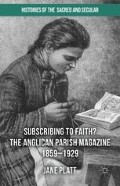Abstract
This chapter explores the circumstances leading to the formation of the first successful inset, Parish Magazine, investigating its content and the motives of its editor, John Erskine Clarke, and noting the significance of Clarke’s employment of the content and style of popular mid-century family magazines. Parish Magazine’s impact was such that it became a highly successful magazine in its own right, while forming the pattern for the many insets which followed it.
Access this chapter
Tax calculation will be finalised at checkout
Purchases are for personal use only
Preview
Unable to display preview. Download preview PDF.
Notes
J. Erskine Clarke, ‘The Parish Magazine’: Journal of the Society of Arts VIII (November 1860), 827–9, 827.
Josef L. Altholz (1989) The Religious Press in Britain, 1760–1900 (New York), p. 10.
J. Erskine Clarke (1861) Plain Papers on the Social Economy of the People (London); Fuller, Erskine Clarke, chapter 13.
See Edward Norman (1987) The Victorian Christian Socialists (Cambridge), pp. 7–9; Kenneth Hylson-Smith (1989) Evangelicals in the Church of England (Edinburgh), pp. 208–10; Gerald Parsons (1988) ‘Social Control to Social Gospel: Victorian Christian Social Attitudes’. In Gerald Parsons (ed.), Religion in Victorian Britain 2, Controversies (Manchester), pp. 39–62.
A. J. Hobbs (2009) ‘When the Provincial Press Was Not the National Press (ca. 1836–1900)’. International Journal of Regional & Local Studies 2(5): 16–43; David McKitterick describes the ‘shared and independent’ nature of such newspapers which allowed readers to read national material alongside their own: David McKitterick (ed.) (2009) The Cambridge History of the Book in Britain 6, 1830–1914 (Cambridge), p. 66.
‘The Parish Magazine’. Journal of the Society of Arts VIII (November 1860), 828.
Church Congress Report (1864) (London), pp. 192–4.
Richard D. Altick (1998) The English Common Reader: A Social History of the Mass Reading Public, 1800–1900, 2nd edition (Columbus), p. 360. Sally Mitchell (1980) analyses this magazine’s content in ‘The Forgotten Woman of the Period: Penny Weekly Family Magazines of the 1840s and 1850s’. In Martha Vicinus (ed.), A Widening Sphere: Changing Roles of Victorian Women (London), pp. 31–3; see also Sally Mitchell (1981) The Fallen Angel: Chastity, Class and Women’s Reading: 1835–80 (Bowling Green, OH), chapter 1.
Flora Thompson (1945, 1973 edition) Lark Rise to Candleford (Harmondsworth), pp. 59, 94.
Margaret Dalziel (1957) Popular Fiction 100 Years Ago (London), pp. 24–5.
Callum G. Brown (2001) The Death of Christian Britain (Abingdon and New York), p. 52.
For example, Legh Richmond (1814) The Dairyman’s Daughter (London); see Driss Knickerbocker (1981) ‘The Popular Religious Tract in England 1790–1830’ (Unpublished PhD thesis, University of Oxford), pp. 242–7.
Gerald Parsons (1988) ‘Victorian Religion: Paradox and Variety’. In Religion in Victorian Britain, 1 (Manchester), pp. 1–13.
Boyd Hilton (1988) The Age of Atonement: The Influence of Evangelicalism on Social and Economic Thought, 1795–1865 (Oxford), chapter 8.
Aileen Fyfe (2004) Science and Salvation: Evangelical Popular Science Publishing in Victorian Britain (Chicago and London), pp. 269–70.
J. M. Swift (1929) The Parish Magazine (London and Oxford), pp. 37–8.
Quoted in Peter Croft (1993) The Parish Magazine Inset (Blandford Forum), pp. 22–3.
John Maynard (1993) Victorian Discourses on Sexuality and Religion (Cambridge), pp. 141–50; Brian Harrison (1967) ‘Religion and Recreation in Nineteenth-Century England’. Past & Present 38: 98–127.
Margaret Beetham and Kay Boardman (2001) (eds) Victorian Women’s Magazines: An Anthology (Manchester and New York), pp. 221–2.
See Michael Twyman (2009) ‘The Illustration Revolution’. In David McKitterick (ed.) The Cambridge History of the Book in Britain VI, 1830–1914 (Cambridge), pp. 117–43, 140–1.
J. Erskine Clarke, ‘The Parish Magazine’. Journal of the Society of Arts VIII (November 1860), 827.
Peter Croft (2001) A Victorian Church Newspaper (Blandford Forum), pp. 14–15.
F. J. Harvey Darton (1932) ‘The Youth of a Children’s Magazine’. In Brian Alderson (1999) (ed.) Children’s Books in England, Five Centuries of Social Life, 3rd edition (Newcastle, Delaware and London), p. 343.
Erskine Clarke (1862) Church Stories (London), p. vi.
Roger Ingpen, ‘Weir, Harrison William (1824–1906), ODNB. For an appreciation of Weir’s talent see John M. Darton (1879) Brave Boys who have become illustrious men of our time, forming bright examples for emulation by the youth of Great Britain (London), pp. 230–5.
John Cordy Jeaffreson (1862) ‘Church Stories’. Athenaeum (1811): 48.
Crockford’s Clerical Directory (1908) (London), pp. 275–6.
LSE Library, Booth Archive: Charles Booth (1902–1903), Life and Labour of the People in London (7 vols), Third Series: Religious Influences (London): Manuscript Notebooks, B294; for Battersea PM, see Birmingham Pictorial and Dart (January 1898).
J. Erskine Clarke, ‘The Parish Magazine’. Journal of the Society of Arts VIII (November 1860), 827.
By 1900 many ‘improving’ magazines placed their illustrated serial story on the cover: Callum Brown (2001) The Death of Christian Britain (Abingdon and New York), p. 71.
For ‘the church in danger’, see David Nash (2013) Christian Ideals in British Culture: Stories of Belief in the Twentieth Century (Basingstoke), p. 9.
Author information
Authors and Affiliations
Copyright information
© 2015 Jane Platt
About this chapter
Cite this chapter
Platt, J. (2015). Erskine Clarke and Parish Magazine. In: Subscribing to Faith? The Anglican Parish Magazine 1859–1929. Histories of the Sacred and Secular 1700–2000. Palgrave Macmillan, London. https://doi.org/10.1057/9781137362445_3
Download citation
DOI: https://doi.org/10.1057/9781137362445_3
Publisher Name: Palgrave Macmillan, London
Print ISBN: 978-1-349-57354-7
Online ISBN: 978-1-137-36244-5
eBook Packages: Palgrave History CollectionHistory (R0)

